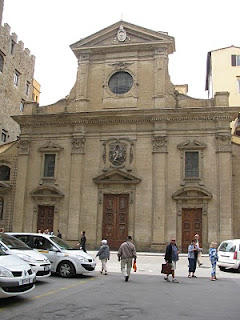Gucci. Prada. Ferragamo. Armani. Valentino. Versace. Pucci. Italian names have been synonymous with high fashion for decades and fashion has been a huge part of Italian culture. The “made in Italy” tag is treated with respect here, and people flock from all over the world to Italy in order to buy leather boots, a little black dress or a nice-cute suit. Florence in particular has had a lot of success in the area of fashion, although Milan has come to be the fashion capital of Italy. The Gucci brand was founded by Guccio Gucci here in 1921. Salvatore Ferragamo also founded his brand of high fashion shoes here. The high-end clothing line Pucci is also Florentine. In addition, Florence is also well-known for its high-quality leather-works, the Santa Croce leather school being an important institution here.
In Florence today all the famous fashion houses can be found on Via Tornabuoni, a sort of Florentine “Fifth Avenue” or “Rodeo Drive”. The street runs from the Arno River at the Santa Trinita bridge and up by Palazzo Strozzi. Here you can find stores representing all the famous Italian houses and some other fashion names you might recognize: Hermés, Tommy Hilfiger, Tiffany & Co., Burberry, and so on. If the stores are a little out of your price range, the street is still a good place for a nice stroll filled with window-shopping and people-watching. The street is named after the Tornabuoni family, a wealthy and prominent banking and merchant family from the days of the Medici. The family was also very involved in Florentine politics, serving as ambassadors to Rome and top-ranking officials in the Florentine government. Like the Medici, the Tornabuoni family members were also great patrons of the arts. Lucrezia Tornabuoni married into the Medici family and is the mother of Lorenzo the Magnificent.
At the beginning of Via Tornabuoni, where the street meets the river, is the Ferragamo store in an old palazzo dating from the fourteenth century that has belonged to the Ferragamo company throughout the 1900s. The store also houses a small museum in the basement. Exhibits in the museum change all the time. Typically there are exhibits on different shoes made by Salvatore Ferragamo and how he has influenced fashion and footwear over the years. There are also exhibits dedicated to certain influential stars who had close relationships with Ferragamo and relied on him for their shoes. The museum is small but has a lot to offer. They put together interesting and modern displays and have a comfortable video room. Double check the exhibit before visiting (the exhibit is advertised on the side of the building where the entrance to the museum is, on the side of the building furthest from the river) to make sure that it is something you are interested in seeing. Entrance to the museum is 5€ and no discounts are offered. Pop upstairs into the store for a look around as well to see modern Ferragamo. Most of the items are a little pricey, but some smaller accessories (like address books or stationary sets) can be bought for less than 15€. Across the street from the Ferragamo store and museum is the tranquil Santa Trinita church, noted for its frescoes by famous Renaissance artist Ghirlandaio who would go on to be an important teacher of Michelangelo.



